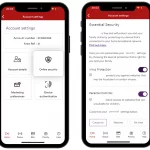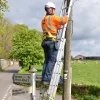Vodafone UK Set 5G Standalone Coverage Target for Scotland

Vodafone has reaffirmed its commitment to providing 5G Standalone (5GSA) tech to nearly 90% of Scotland’s landmass by 2034 as a result of its proposed merger with Three UK. The operator also commits to exceeding the UK Government’s Shared Rural Network target of bringing 4G to 74% of Scotland’s geography by pushing it to over 89% by 2027.
Most existing 5G networks in the UK are Non-Standalone (NSA) based, which in simple terms means they partly rely on older 4G infrastructure. By comparison, 5GSA reflects a pure end-to-end 5G network that can also deliver improvements such as ultra-low latency times (fast), better mobile broadband upload speeds, network slicing capabilities, better support for Internet of Things (IoT) devices, increased reliability and security.
Last year Vodafone became the first UK operator to launch a 5GSA network with their new “5G Ultra” package for consumers (here), although its coverage was initially limited to parts of London, Manchester, Glasgow and Cardiff, with more cities to follow. But in February 2024 they were joined by O2 (VMO2), which has initially gone live in parts of 14 cities and their service comes at “no extra” cost to customers (here).
Advertisement
However, Vodafone, as part of their proposed mega-merger with Three UK (here), has been much firmer in its targets and pledged to reach more than 99% of the UK’s “population” with their 5GSA network by 2034 and to push fixed wireless access (home broadband) to 82% of households by 2030. But this week Vodafone also confirmed, as part of their target, that their 5GSA “landmass” coverage figure for Scotland would also reach “nearly” 90% by 2034 (note: the flip-flopping between using population and landmass / geographic coverage targets for the same thing can get a bit confusing).
The commitment was made as part of a “reception” recently held at the Scottish Parliament in Holyrood. The reception was attended by Members of the Scottish Parliament, as well representatives from relevant trade associations, think tanks and media.
Rachael Hamilton, Shadow Cabinet Secretary for Rural Affairs and Islands, said:
“I was delighted to sponsor Vodafone UK’s Digital Society event in the Scottish Parliament. Sadly, there is a digital divide between urban and rural areas in Scotland, with 42% of rural properties in 5G total not spots. I was therefore pleased to hear about Vodafone UK’s plans to roll out a 5G network across Scotland. This would deliver significant benefits and opportunities for people, communities and businesses in rural areas, such as in my constituency in the Borders.”
Andrea Dona, Chief Network Officer at Vodafone UK, said:
“Connectivity is vital for everyone – whatever their postcode – and this new research reveals the extent to which people in rural Scotland are experiencing digital exclusion. Evidently, we need to accelerate the rollout of 5G infrastructure to all of Scotland. With our proposed merger with Three UK, we would be able to bring 5G SA to over 89% of the Scottish landmass by 2034, ensuring rural Scotland is not left behind.”
This activity follows Vodafone UK’s recent research, which found that 91% of Scotland’s rural areas are total 5G “not-spots“, compared to just 20% of Scotland’s urban areas. Vodafone also identified significant regional disparities, with a rural area in Scotland being 62% more likely to have no 5G at all, compared to a rural area in England.
All of this is clearly designed to drum up political support for their merger, while also supporting the Government’s Wireless Infrastructure Strategy (WIS), which last year set out an ambition for “all populated areas to be covered by ‘standalone’ 5G (5G-plus) by 2030” (here). But it’s worth noting that Vodafone’s 5GSA targets aren’t legally binding.
Advertisement
Mark is a professional technology writer, IT consultant and computer engineer from Dorset (England), he also founded ISPreview in 1999 and enjoys analysing the latest telecoms and broadband developments. Find me on X (Twitter), Mastodon, Facebook, BlueSky, Threads.net and Linkedin.
« Scotland Set to Tender for Rural Project Gigabit Broadband Rollout























































What’s the point in Vodafone “Ultra 5G”/ 5G SA, if they only allow specific Samsung Android phones to access it, more specifically, Last years model, not even this years model
I am an iOS user, so I am not even supported on the iPhone 15 Pro Max
O2 has a similar problem, but such teething problems with a new network technology aren’t uncommon.
It’s a soft launch/trial. Eventually the tech will be extended to all 5G handsets
There are lots and lots of compatibility issues with 5G standalone.
Even the handsets which are supported have issues.
If you look at the Vodafone, VMO2, and even Samsung’s own forums, lots of people are struggling with it.
Some users cant connect. Others connect but get disconnected within a minute.
iOS has major issues with battery life when it comes 5G standalone, reported in other markets.
Even with 5G non-standalone there is battery drain as it keeps switching between different network types.
I’ve switched mine to 4G only and am experiencing around 20% battery life and in some cases better speeds than 5G (I live in London)
Not bothered about 5G standalone. One needs to ask themselves what exactly does anyone need anything more than 30Mbs download throughput on a mobile device? You cna stream 4K video with less than that if you wanted to.
I would say for the majority of users robust ubiquitous LTE coverage is far important than having ridiculous throughout speeds over 5G standalone.
The problem with 5G (N/)SA is that it’s not ubiquitous enough so your device ends up swapping between network types.
Currently in China where this isn’t an issue and my battery life is fine.
Vodafone needs to stop talking about 5G and actually roll it out!
They are the only network that has yet to roll out any useful 5G in NE Scotland.
They have pockets of coverage in Aberdeen and, best I can tell a single mast in Inverness but they have absolutely nothing along the A96 corridor in between.
All other networks have some outdoor coverage in several of the major towns along the route
they don’t even have 5G in Cambridge 🙂